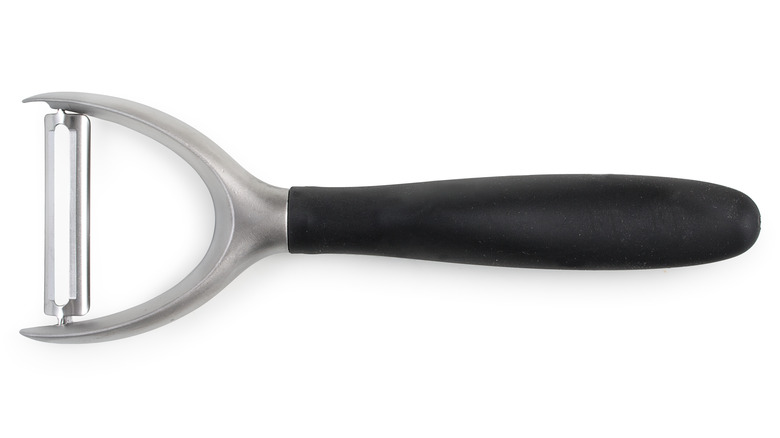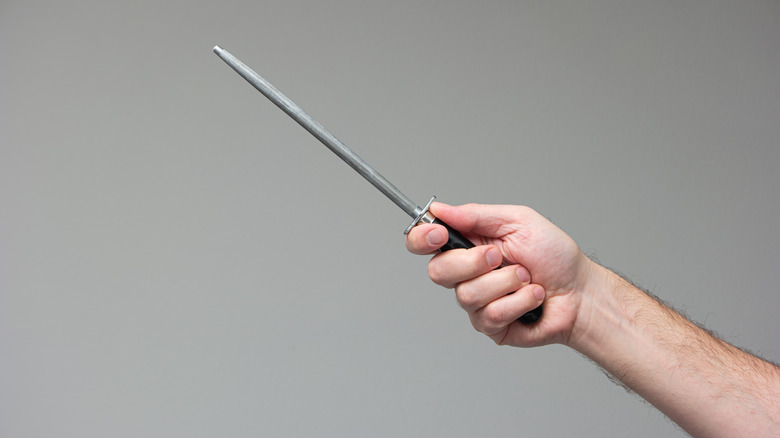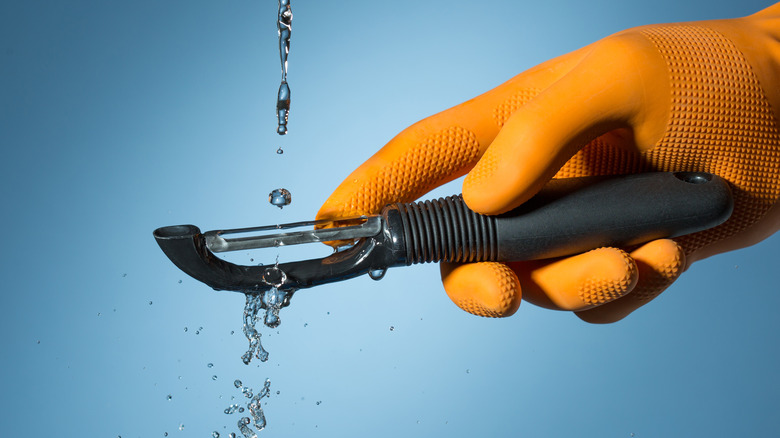The Best Way To Sharpen Your Vegetable Peelers
We may receive a commission on purchases made from links.
Whether you call them potato or vegetable peelers, this kitchen gadget is indispensable for plenty of tasks, like curling chocolate, shaving fruit peels to garnish cocktails, or peeling spuds to make a batch of creamy mashed potatoes. Unlike Grandma's paring knife, vegetable peelers are safer and faster for peeling or shaving ingredients, especially if yours has two blades.
Vegetable peelers are available in two styles: straight swivel peelers and y-peelers, with the latter being more popular. Since they are typically less expensive than knives, they often don't get the same attention and maintenance. However, their steel blades dull over time, making peeling potatoes, carrots, and other skinned produce a more difficult task. If you have to apply a lot of pressure to remove the peel or go over the same spot multiple times, the blade is dull, and it's time to do something about it.
But, rather than hacking away at your food or investing in a new peeler (although if you're Ina Garten, you do so constantly), you can sharpen the blade using a knife steel or honing rod. This long, cylindrical tool with a handle likely came with your knife set and is used to realign the blade's edge so it feels sharper and cuts without resistance or slipping. It can also be used to sharpen your peeler if its blade is made of carbon or stainless steel. (Unfortunately, this method will ruin ceramic or serrated-edged vegetable peelers, so seek a professional if yours is that style and needs some TLC.)
How to use a honing rod to sharpen vegetable peelers
In addition to the honing rod, you will need a cutting board and a clean dishtowel to sharpen your vegetable peeler. It helps to fold a piece of cardboard under the blade to prevent it from swiveling as you sharpen.
As a TikToker demonstrates, the honing rod's tip allows you to push the blades forward to realign the edges. The rod's ridges are then used along the length of the peeler's blade to make it sharp again.
@oldscoolkevmo How to Sharpen a Vegetable Peeler! #tiktokhacks #tiktokchefs #easy #cool #whatatreat #cheers #BridgertonScandal
♬ Happy / Video CM / Ukulele ♬ Cooking / Family(897363) – ImoKenpi-Dou
If you don't have a honing rod, this can be done with a file, too — either a metal nail file or one from your workshop. Use light pressure as you draw the file or steel along the blade several times, holding it at a 15- to 20-degree angle. Once done, wipe off the blade with the dishtowel to remove any tiny bites of metal that came off and test whether the edge is razor sharp again. Repeat the process if necessary. This technique can also be used to sharpen dull cheese slicers.
More tips for maintaining your vegetable peeler
While most models of veggie peelers are dishwasher-safe, like expensive knives, it's best to hand-wash them to keep them sharper for longer. Dishwasher detergent can be abrasive and the machine's water pressure causes items to bang against each other, which can leave nicks on the blade. (This movement can also damage the dishwasher's wire shelves.) Sharp blades can chip away at the plastic coating during cycles, which can cause the underlying metal wire to rust.
Although carbon steel-bladed vegetable peelers stay sharp longer than stainless steel, carbon is more prone to rusting. Carbon steel vegetable peelers should be washed and dried immediately to prevent the metal from oxidizing.
If you use the peeler often and find that you're frequently sharpening it, a few more expensive models have replaceable blades. The Forever Peeler retails for $28 and has an additional blade to swap out the dull one. The Suncraft Ever Peeler retails for $30 and is available for left and right-handed cooks. The replacement blades are sold separately for roughly $15 each.



